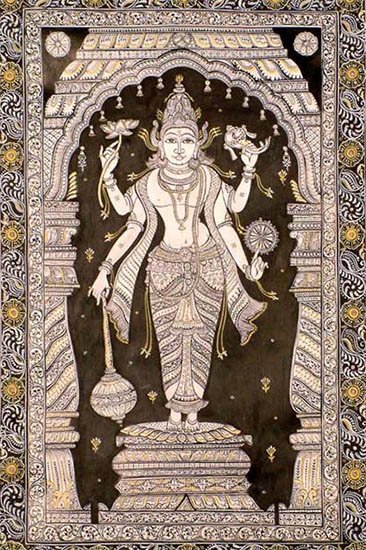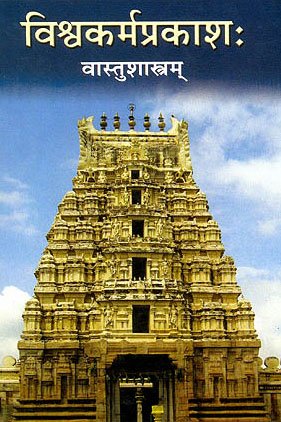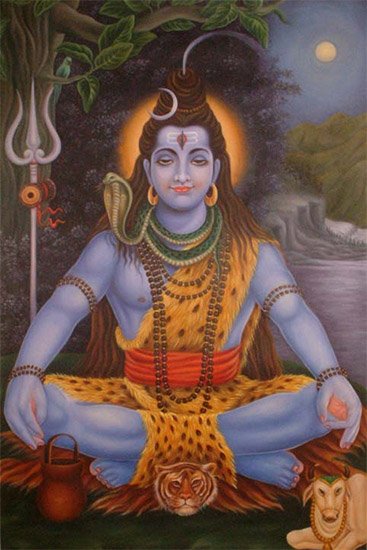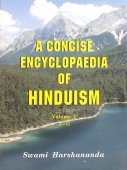Bhadrapitha, Bhadrapīṭha, Bhadra-pitha: 11 definitions
Introduction:
Bhadrapitha means something in Hinduism, Sanskrit. If you want to know the exact meaning, history, etymology or English translation of this term then check out the descriptions on this page. Add your comment or reference to a book if you want to contribute to this summary article.
In Hinduism
Shilpashastra (iconography)
Source: Wisdom Library: Śilpa-śāstraBhadrapīṭha (भद्रपीठ) is a Sanskrit technical term, referring to a type of pedestal (pīṭha), used in the construction of liṅgas. It is named after the kind of moulding (bhadra). The word liṅga refers to a symbol used in the worship of Śiva and is used thoughout Śaiva literature, such as the sacred Āgamas.
Source: Google Books: Elements of Hindu iconographyBhadrapīṭha (भद्रपीठ) is another seat (pīṭha), the height whereof is also divided into sixteen parts, of which one forms the thickness of the upāna or the basal layer, four of the jagati or the next higher layer, three of the kumuda, one of the paṭṭika, three of the kaṇṭha, one of the second paṭṭika, two of the broader mahāpaṭṭika and one of the ghṛtavāri the topmost layer. Bhadrapīṭha may be either circular or rectangular.

Shilpashastra (शिल्पशास्त्र, śilpaśāstra) represents the ancient Indian science (shastra) of creative arts (shilpa) such as sculpture, iconography and painting. Closely related to Vastushastra (architecture), they often share the same literature.
Vastushastra (architecture)
Source: OpenEdition books: Architectural terms contained in Ajitāgama and RauravāgamaBhadrapīṭha (भद्रपीठ) refers to “n. of a type of pedestal §§ 3.7, 8, 35, 44; 5.3, 4, 17.”.—(For paragraphs cf. Les enseignements architecturaux de l'Ajitāgama et du Rauravāgama by Bruno Dagens)

Vastushastra (वास्तुशास्त्र, vāstuśāstra) refers to the ancient Indian science (shastra) of architecture (vastu), dealing with topics such architecture, sculpture, town-building, fort building and various other constructions. Vastu also deals with the philosophy of the architectural relation with the cosmic universe.
Shaivism (Shaiva philosophy)
Source: Google Books: Manthanabhairavatantram (shaivism)Bhadrapīṭha (भद्रपीठ) (Cf. Pīṭha) refers to the “place where the sacrificial jar is placed”.—The Jayadrathayāmala refers to the place where the sacrificial jar is placed in the course of a rite as the ‘bhadrapīṭha’. The Brahmayāmala refers to the place where the seat is placed for the teacher to sit as the ‘yogapīṭha’. The Jayadrathayāmala uses the same term to denote the seed-syllable OṂ and the innermost part of a maṇḍala. The Kubjikā Tantras do the same both with reference to the external maṇḍala and its internal counterpart in the End of the Twelve.

Shaiva (शैव, śaiva) or Shaivism (śaivism) represents a tradition of Hinduism worshiping Shiva as the supreme being. Closely related to Shaktism, Shaiva literature includes a range of scriptures, including Tantras, while the root of this tradition may be traced back to the ancient Vedas.
Languages of India and abroad
Sanskrit dictionary
Source: DDSA: The practical Sanskrit-English dictionaryBhadrapīṭha (भद्रपीठ).—
1) a splendid seat, chair of state, throne; औदुम्बरं भद्रपीठमभिषेकार्थमाहृतम् (audumbaraṃ bhadrapīṭhamabhiṣekārthamāhṛtam) Rām.2.14.34; उपतस्थुः प्रकृतयो भद्रपीठोपवेशितम् (upatasthuḥ prakṛtayo bhadrapīṭhopaveśitam) R.17.1.
2) a kind of winged insect.
Derivable forms: bhadrapīṭham (भद्रपीठम्).
Bhadrapīṭha is a Sanskrit compound consisting of the terms bhadra and pīṭha (पीठ).
Source: Cologne Digital Sanskrit Dictionaries: Benfey Sanskrit-English DictionaryBhadrapīṭha (भद्रपीठ).—a throne, [Vikramorvaśī, (ed. Bollensen.)] 87, 13.
Bhadrapīṭha is a Sanskrit compound consisting of the terms bhadra and pīṭha (पीठ).
Source: Cologne Digital Sanskrit Dictionaries: Cappeller Sanskrit-English DictionaryBhadrapīṭha (भद्रपीठ).—[neuter] splendid seat, throne; [masculine] a cert. winged insect, used by thieves.
Source: Cologne Digital Sanskrit Dictionaries: Monier-Williams Sanskrit-English Dictionary1) Bhadrapīṭha (भद्रपीठ):—[=bhadra-pīṭha] [from bhadra > bhand] n. a splendid seat, throne, [Pāraskara-gṛhya-sūtra; Rāmāyaṇa] etc.
2) [v.s. ...] ([probably] m.) a kind of winged insect, [Mṛcchakaṭikā]
[Sanskrit to German]
Sanskrit, also spelled संस्कृतम् (saṃskṛtam), is an ancient language of India commonly seen as the grandmother of the Indo-European language family (even English!). Closely allied with Prakrit and Pali, Sanskrit is more exhaustive in both grammar and terms and has the most extensive collection of literature in the world, greatly surpassing its sister-languages Greek and Latin.
Kannada-English dictionary
Source: Alar: Kannada-English corpusBhadrapīṭha (ಭದ್ರಪೀಠ):—
1) [noun] a holy or royal seat.
2) [noun] (arch.) a type of pedestal of the phallus or an image.
Kannada is a Dravidian language (as opposed to the Indo-European language family) mainly spoken in the southwestern region of India.
See also (Relevant definitions)
Partial matches: Bhadra, Pitha, Pita.
Full-text: Mandapitha, Bhadrasana, Yogapitha, Pretasana, Sukhasanamurti, Storey, Bhumika, Kurmasana, Simhasana, Abhisheka.
Relevant text
Search found 9 books and stories containing Bhadrapitha, Bhadra-pitha, Bhadra-pīṭha, Bhadrapīṭha; (plurals include: Bhadrapithas, pithas, pīṭhas, Bhadrapīṭhas). You can also click to the full overview containing English textual excerpts. Below are direct links for the most relevant articles:
Early Chola Temples (by S. R. Balasubrahmanyam)
Bronze, group 1: Late Pallava and Early Chola—Age of Vijayalaya (a.d. 785-871) < [Chapter XI - Sculpture]
Bronze, group 3: Age of Parantaka I (a.d. 907 - 950) < [Chapter XI - Sculpture]
Temples of Munnur (Historical Study) (by R. Muthuraman)
Images of Brahma < [Chapter 5]
The Linga Purana (by J. L. Shastri)
Chapter 1 - The greatness of Nārāyaṇa < [Section 2 - Pūrvabhāga]
Vishnudharmottara Purana (Art and Architecture) (by Bhagyashree Sarma)
5. Different Parts of a Temple < [Chapter 4 - Temple Building]
Vinaya (3): The Cullavagga (by T. W. Rhys Davids)
Cullavagga, Khandaka 6, Chapter 2 < [Khandaka 6 - On Dwellings and Furniture]
Amaravati Art in the Context of Andhra Archaeology (by Sreyashi Ray chowdhuri)
Impact of Amarāvatī on early schools of art of South-East Asia < [Chapter 5 - Impact of Amarāvatī Art]
Related products
